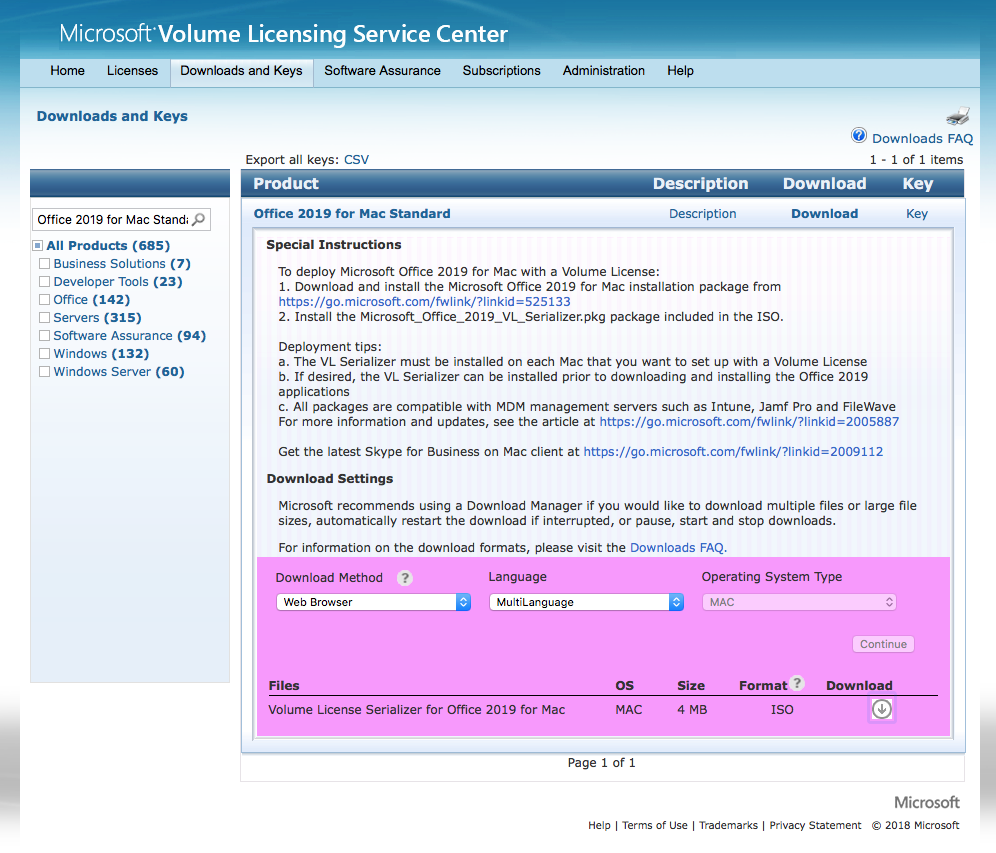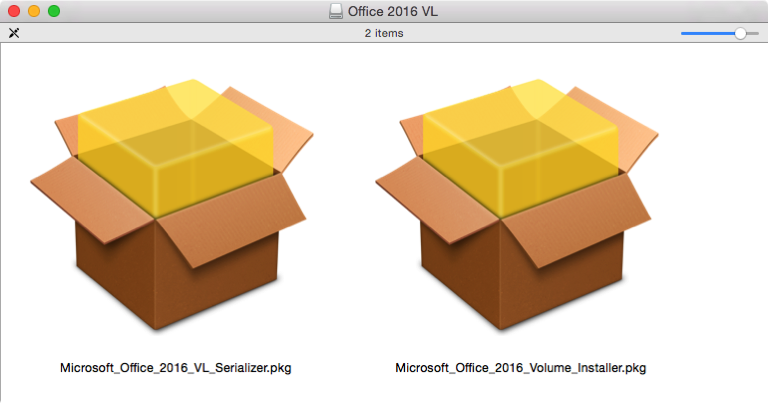Soon Microsoft are to release an update to the Office 2016 Volume License installer on VLSC.
This update is 15.17 & is the first that has a few changes that may affect the way you deploy Office 2016.
These changes are going to be later enforced in 15.20 & onwards. Below are some details on the changes, some of the why & how via the power of the MacAdmins.org Slack & the awesome @pbowden that some of us have had a sneak peek.
Contents
As of last week, Microsoft released built 16.17 of Microsoft Office. This updates clients from Office 2016 to Office 2019 (and has the nasty side effect of unlicensing you if you don’t run the Office 2019 volume serializer). Microsoft is also continuing to release security updates for Office 2016, which continue to have the 16.16.x release.
- Microsoft Office 2016 for Mac 大企业版 Microsoft Office 2016 for Mac 开心版. Office 2016具有节省时间的功能、全新的现代外观和内置协作工具,可帮助您更快创建和整理。此外,您可以将您的文档保存在OneDrive中,并从任何地方访问这些文档。.
- Helpers for OS X packaging and MacAdmins. Contribute to maxschlapfer/MacAdminHelpers development by creating an account on GitHub.
- I will be upgrading Mac Office 2016 to Mac Office 2019 and will be using Mac Seralizer to. Here are the screen shots: Now we will try to activate Mac Office 2019 using Mac Serializer. Open Word 2019 to make sure it is activated. Now we will perform the update for Mac Office 2019. This complete Mac Office 2019 update on Mac Book Pro.
- TheVLSerializerisa smallcommand-linebasedtoolwhichactivatesthecurrentlyinstalledversionofOffice2016forMaconthelocalcomputer. Background TheVolumeLicenseeditionofOffice2016forMacallowseligiblecustomerstodeployapre-activatedcopyofOfficeapplicationsonagivenusers’ computer.
- 1 What’s Changing?
When you download the .iso from VLSC you’ll notice two packages within it:
The change is the new second pkg: “Microsoft_Office_2016_VL_Serializer.pkg”
What’s that about?
Well, for a while now it’s been fairly common practice to deploy the Office license to Macs outside of the Office installers or updates.
This came about as on occasion an Office Update or Installer would delete the file.
However, whilst the deletion itself was a bug, the ability to use the license.plist across Macs was also a bug.
What is it & should I use it?
With Office 2016, Microsoft are moving to a device based serialisation method. Which means that deploying the plist /Library/Preferences/com.microsoft.office.licensingv2.plist will no longer work.
This device based serialisation is based around the generating a license on the Mac that is to be running Office 2016.
So if you employ monolithic imaging or deploy Office 2016 via a Composer snap shot etc, the serialisation will not work. (Please don’t deploy Office 2016 via a Composer snap shot, use the pkg).
Also, if you install Office 2016 whilst booted to another volume (as in when installing via a NetBoot or NetInstall volume or something like Target Mode Imaging), again the serialisation will not work.
To install Office 2016 from another volume & have the serialisation work, cache it locally on the Mac being imaged & install on first boot or if using Casper Imaging check “Install on boot drive after Imaging” for the PKG from within Casper Admin.
However, to enable Office 2016 to be correctly licensed in the multitude of deployment scenarios that we mac admins employ, @pbowden & his team have created the “Microsoft_Office_2016_VL_Serializer.pkg”
Running this will correctly serialise the Office 2016 suite, & should be run from the Mac that’s running the suite. So again, can be added post imaging & then the suite will be correctly serialised.
To be clear, this will only affect you if using the Volume Licensed version of Office 2016 & not the Office365 version.
What happens if I carry on copying the licensing.plist?
For now, not much.
15.17 is the first release with the “Microsoft_Office_2016_VL_Serializer.pkg”, from 15.20 (scheduled for Q1 2016) you will have to use the correct license.
How did people find this out?
Well a little over a month ago a gentleman with the nick @pbowden hopped into the #microsoft-office channel on the MacAdmins.org Slack, this was awesome as @pbowden is a: Software engineer for Office for Mac/iOS at Microsoft, a fellow Brit & nice guy.
It’s been a great few weeks with the community sharing feedback with @pbowden & some of us being able to test pre-release installers for Office.
I hope this warning has been as helpful to you, as it was when @pbowden shared it with us.
Both Office 2016 and Office 2019 for Mac are available for installation and updating via Jamf Pro. The default for DEP imaged machines and EPM's third-party patching system is still 2016, but you are free to install or upgrade to 2019 with the instructions below.
Microsoft Office Serializer
Version numbering and names
Microsoft's application versions for 2016 and 2019 are very similar, so it's important to verify that you are installing the correct version. Version numbers up through 16.16.x are Office 2016, while 16.17 and higher are Office 2019. The licensing for these two are mutually exclusive, so be sure to install the matching serializer and application packages. See below for the two sets of packages.
Note that Microsoft's naming scheme for packages has also changed to use underscores instead of spaces for the 2019 packaging. This naming scheme is reflected in our Jamf Pro package names, which means that 2019 packages will appear separately from 2016 packages when sorting them by name.
Deploying the latest Office 2016 with EPM's custom triggers.
You can install the entire Office 2016 suite in one step by calling the epm-thirdparty-office trigger. You can do this either manually on a computer from Terminal by entering `sudo jamf policy -event epm-thirdparty-office` or execute it via Jamf policy by entering that same command into 'Execute Command' field under the 'File and Processes' payload.
If you want only individual applications rather than the entire suite, you can call the following custom triggers. Note that these will install only the application, not the license or Microsoft AutoUpdate. See the next section for the additional packages you will need to install for those components.
epm-thirdparty-excel
epm-thirdparty-onenote
epm-thirdparty-outlook
epm-thirdparty-powerpoint
epm-thirdparty-word
Deploying Office 2016 with custom policy setup
If you prefer to build out deployment policies yourself rather than use the custom trigger outlined above, you can install the 7 component packages yourself. You will want to deploy the serializer, the AutoUpdate, and any or all of the individual applications (like Word and Excel):

- Microsoft Office 2016 Serializer 2.0.pkg
- Microsoft AutoUpdate_3.11.17101000_Updater.pkg (or latest number)
- Microsoft Excel-16.16.18111001.pkg
- Microsoft OneNote-16.16.18111001.pkg
- Microsoft Outlook-16.16.18111001.pkg
- Microsoft PowerPoint-16.16.18111001.pkg
- Microsoft Word-16.16.18111001.pkg
| The version numbers here are examples, and the latest as of 12/01/2018. New versions of Office 2016 are released periodically. It's best to install the latest version of 16.16 that you see available. |
Follow the steps in the below link for software deployment for more details on setting up policies to deploy packages.

Deploying the latest Office 2019 with EPM's custom triggers.
You can install the entire Office 2019 suite in one step by calling the epm-thirdparty-office-2019 trigger. You can do this either manually on a computer from Terminal by entering `sudo jamf policy -event epm-thirdparty-office-2019` or execute it via Jamf policy by entering that same command into 'Execute Command' field under the 'File and Processes' payload.

If you want only individual applications rather than the entire suite, you can call the following custom triggers. Note that these will install only the application, not the license or Microsoft AutoUpdate. See the next section for the additional packages you will need to install for those components.
epm-thirdparty-excel-2019
epm-thirdparty-onenote-2019
epm-thirdparty-outlook-2019
epm-thirdparty-powerpoint-2019
epm-thirdparty-word-2019
Microsoft Office 2016 Vl Serializer

Deploying Office 2019 with custom policies
If you'd like to install Office 2019 with your own policies, the process is similar to 2016; you need to install the newer Serializer package, the newer 2019 application packages, and AutoUpdate.
- Microsoft_Office_2019_VL_Serializer.pkg
- Microsoft_AutoUpdate_4.5.18110402_Updater.pkg
- Microsoft_Excel_16.19.18110915.pkg
- Microsoft_OneNote_16.19.18110915.pkg
- Microsoft_Outlook_16.19.18110915.pkg
- Microsoft_PowerPoint_16.19.18110915.pkg
- Microsoft_Word_16.19.18110915.pkg
| The version numbers here are examples, and the latest as of 12/01/2018. New versions of Office 2016 are released periodically. It's best to install the latest version that you see available. |
Follow the steps in the below link for software deployment for more details on setting up policies to deploy packages.
Deploying updates
If you want to just deploy the latest updates, you can deploy just the individual application packages listed above. Alternatively, you can execute the custom trigger epm-thirdparty to update any outdated packages of Office 2016 and 2019. For details on using the epm-thirdparty trigger, see [Jamf Pro - epm-thirdparty patching]
If you need assistance creating policies for the installation packages please contact the Endpoint Management team at endpointmanagement@mit.edu.
Related articles
Office 2016 For Mac Serializer
See Jamf Pro - Software Deployment for more information on how to create deployment policies.
See [Jamf Pro - Third-party software patching] for information on deploying new updates as they are released.
See [Jamf Pro - epm-thirdparty patching] for more information on using EPM's custom triggers for patching and installing.